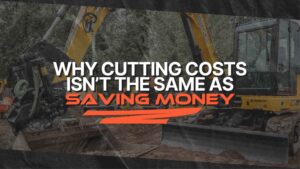What your Foreman’s Job Folder Needs to Include

When I sit back and think “What do I need to succeed as a crew lead?”, my mind goes to the info I’m given as I kick off a new job (aka the Foreman’s Job Folder.) When I was a foreman at Tussey Landscaping, the more info I had, the better decisions I could make, and the less I needed to bother my boss. We got better and better at this over the years.
The info you provide to your crew is vital to helping your crew succeed at what they do.
Foreman’s Job Folder for the Crew Lead
Here’s what I think a foreman deserves to know for every job:
- Unsold work areas or line items (upsell opportunity!)
- Estimated man hours per work area
- The material list is broken out by work area
- Notes from salesperson to crew lead (communicate!)
- Photos (work area, access, staging area, etc.)
- Docs/Designs/Schedule
- Client Info
Unsold work areas or line items
As a foreman, I wanted to know about any line items that the client didn’t go for on the original proposal. To me, this was pure upsell gold! I got a small commission for upsells I did at Tussey, and it was fun. If I saw that the client didn’t go for a water feature beside the patio, or nixed the lighting, bingo. I’d wait until the job was well underway, things are coming together, and the client is thrilled, and then suggest that water feature, lighting, or whatever it was. The client trusted my opinion and often went for it. I had a ton of success doing this. One year I sold over $300k in upsells. As a foreman. I wasn’t a salesperson and didn’t go on a single consultation. Your crew leads can be upselling machines.
Estimated man hours per work area
I know not everyone may think as I did, but I wanted to know the estimated man-hours on each part of the job. And then I wanted to beat them. Do not take shortcuts. But take pride in my work, work efficiently, and beat those man hours. I knew that if I did that, the company made more money. If the company made more money, I could make more money.
The material list is broken out by work area
Nothing was more frustrating than having to call the salesperson to find out how much stone I needed to order, what color the pavers were, or what plants we needed. So needless. Super easy solution – give your crew the list of materials in the job. Then let them use that info to work efficiently, and cut down on that phone tag.
Notes from the salesperson to the crew lead
As a foreman, I wanted to see into the salesperson’s head. What was their vision for the job? What did they envision us tackling first? Did we need any special equipment on day 1 of the job? (I could take responsibility after day 1, but nothing was more frustrating than arriving on the job on day 1 and realizing I needed the dump trailer, etc.) Did the client have any special requests? Did the salesperson tell the client we’d do anything out of the ordinary for them, like save that birdbath, etc.? As the salesperson, you discuss and plan a lot of things with the client. Think about all that from the foreman’s perspective. What would the foreman want to know? Communicate! This can solve so many needless truck runs, mistakes, and phone calls.
Photos
This one doesn’t need much explaining. Pictures are worth a thousand words. As a foreman, it was so helpful to mentally prep for the job if I could see photos before we kicked the job off.
Docs, Designs, Schedule
Include all the vendor order sheets, designs, and when the job’s expected schedule slot is, etc.
Client Info
All I wanted was both the husband’s AND the wife’s names, phone numbers, and addresses. Back in the day before we built SynkedUP, I’d end up letting my paper job folder in the truck, or in the trailer and didn’t have this info with me when I needed it. And I’d have to call the office just to get a phone number. Frustrating. And again, needless inefficiency.
Other Items for the Foreman’s Job Folder?
What are you currently adding to your foreman’s job folder?
I’d love to hear what you’re up to.
Leave me a comment.
Weston

Weston Zimmerman
CEO and co-founder
See SynkedUP in action
Related Articles
What is the Most Difficult Challenge You’ve Overcome?
Cutting costs isn't the same as saving money. Learn how to use leverage, not panic, to drive real profit and...
Why Time Tracking is Critical for Contractors
Cutting costs isn't the same as saving money. Learn how to use leverage, not panic, to drive real profit and...
Why Cutting Costs Isn’t the Same as Saving Money
Cutting costs isn't the same as saving money. Learn how to use leverage, not panic, to drive real profit and...
Slow Down to Speed Up
A quick leadership gut check: Are you building what really matters? Slow down, realign, and lead with intention.
The One Calculation Every Contractor Should Know
Contractors: If you’re not factoring in overhead, you're not pricing right. Learn how to calculate breakeven and stop guessing your...
What Owns Your Day? Urgency or Importance?
Stuck in a cycle of chaos and urgent tasks? Break the cycle with better systems, clear processes, and leadership that...
Taking Care of Your Team
Leadership isn't barking orders - it's listening, appreciating, and building problem solvers. Here's how to lead without burning out.
The Cost of Avoiding Issues in Your Business
Avoiding stuff in business adds up, with interest. Don't try harder, build systems that make success default. Do hard things,...
Leveraging Your Job Data for More Accurate Estimates
Stop estimating from the gut. Track time, collect job data, and turn it into faster, more accurate production rates.
How the Best Contractors Ensure Profitability
Running over estimated hours is one of the biggest silent profit killers in contracting. Here's how to track it, catch...










4 Responses
Hi Weston, I think my foremen’s would say you are spot on. As the salesman, I also have figured out that the more information that I send to my foremen’s the less they are bothering me at the beginning of the job. (Just a punch on Synked Up getting the Photo option upgraded). We still use Apple Notes for the Photos and general notes to the foremen’s. On a lot of jobs I might have 10 or more pictures with drawings on the pictures. I would love to see that option on Synked Up.
Thanks Ron! You should be able to upload any number of photos you want. Hit me up if you are having trouble.
Weston,
Great post! As a project manager, this is something I see very important in the industry, and just another tool in the toolbox. I’ve called it job package, field packet, and I see that you call it job folder. Either way, it’s essential for transferring job information and special instructions that create more efficiency and transparency in the field.
Some of the other categories in addition to what you mentioned would be:
– MaterialSstaging
– Parking and Access
– Disposal, Recycling, and Material Pickup Locations (nearest to job site)
– Sub Contractor company name, job details, and cell phone number. Scheduling if possible
– Material pictures and dimensions
– 3D Rendering screenshots of project
– Special Instructions related to certain features, grades, and other elements not obvious to the crew
– Lighting plan
– Turf plan and specific layout
– Plant layout
– Emergency Utility Contact List
Obviously some overlap, and sometimes you want to give more information but time management is key. By creating these packets, it eliminates a lot of questions in the field, and creates a better work environment for everyone.
Great input! Thanks for the detailed comment, some great value added. Keep on chiming in!